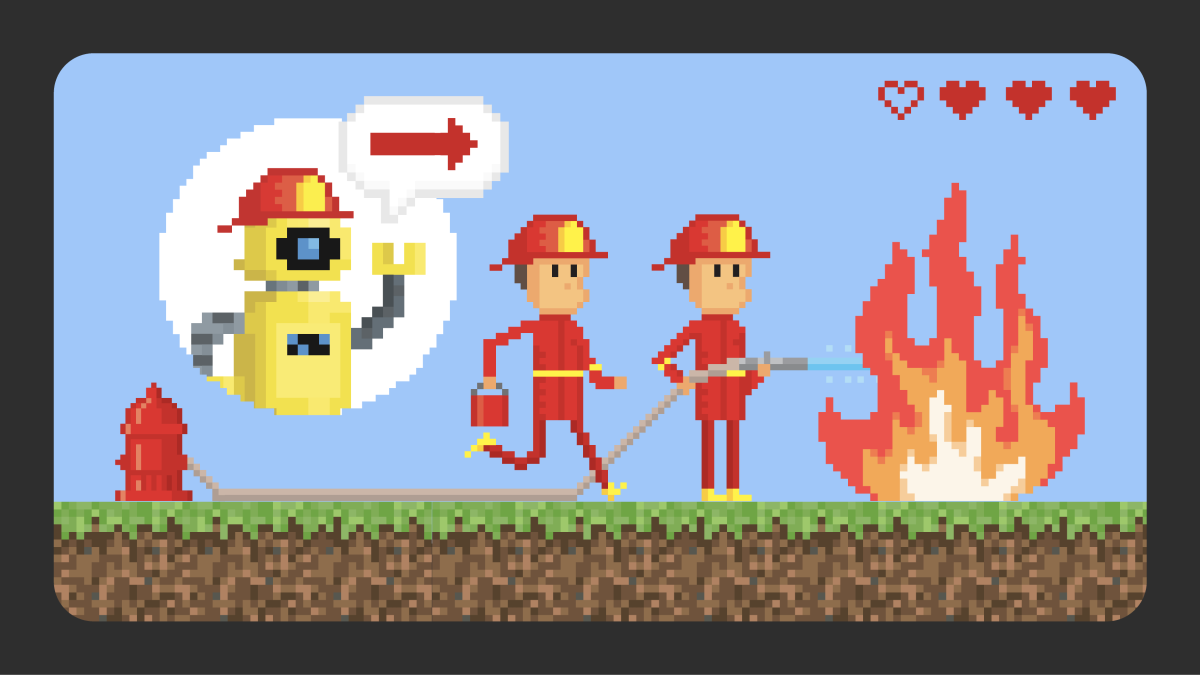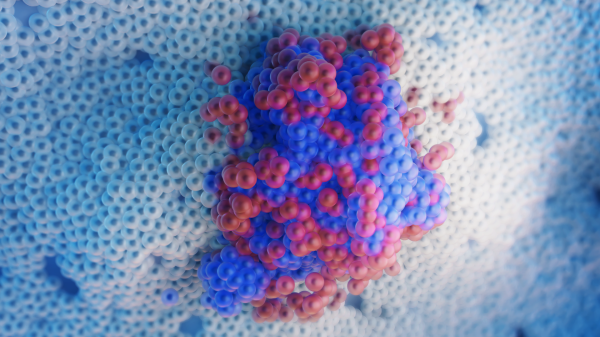Teaching AI about social intelligence through Minecraft

Using Minecraft allowed researchers to design complex and highly dynamic tasks in a simulated urban search and rescue mission — such as a fire sweeping through a small town. Illustration by Andy Keena
Despite all the mind-blowing things artificial intelligence already can do — from writing essays and creating visual art to assisting doctors with diagnosing disease — it still lacks a basic understanding of what makes humans tick.
AI can make quick, lifesaving decisions — such as finding the fastest route to victims in a collapsed building — but it cannot understand why the rescue team diverts from that route or predict how the team might act in certain situations.
Current AI is a good tool but a poor teammate, because of its lack of human understanding.
That is why the research and development arm of the U.S. Department of Defense, the Defense Advanced Research Projects Agency (DARPA), is exploring new ways to build social skills in AI systems that would allow humans and machines to work effectively together.
And clues on how to create machines with social intelligence have been found in an unexpected place: the popular video game Minecraft.
Arizona State University researchers teamed up with Aptima — a company that develops solutions to optimize and improve human performance in mission-critical, technology-intensive settings — during a four-year program funded by DARPA called Artificial Social Intelligence for Successful Teams, or ASIST. The project aims to improve the social intelligence of artificial intelligence and make it better able to assist teams of humans working in complex environments, including national security missions.
Researchers from the Center for Human, Artificial Intelligence, and Robot Teaming, or CHART —part of ASU’s Global Security Initiative — generated data from 1,160 Minecraft games, which represents the largest publicly available human–AI team research dataset in history.
Building teams of the future
CHART is at the forefront of a new science of human, AI and robot teaming. It synthesizes research across computer science, robotics, law, art and social science to create human-machine systems that will revolutionize how we ensure national security.
“Typically, team research is statistically underpowered because it’s hard to schedule and convene participants at the same time,” says Nancy Cooke, CHART senior scientific advisor and principal investigator on ASU’s portion of the project. “But we found special ways of recruiting participants by hosting Minecraft competitions and virtual hackathons and giving awards to high performers.”
More than 200 participants — including representatives from the Massachusetts Institute of Technology; Cornell; the University of Southern California; and Carnegie Mellon University — played a role in the ASIST research. ASIST is one component of a broader DARPA initiative called AI Forward, which is taking a deep look at how to reliably build trustworthy AI systems by examining AI theory, AI engineering and human-AI teaming.
One aspect of this approach centers on developing AI machines that function more as colleagues than just tools to execute human-programmed rules.
To envision AI as a colleague versus a ChatGPT answer box, consider the "Star Trek" character Data, a self-aware and sentient android who serves as the second officer and chief operations officer aboard the starship Enterprise.
“Data can interact with human beings, kind of understand their feelings and anticipate what they’re asking for,” says Jamie Gorman, CHART director and professor of human systems engineering in The Polytechnic School. “Getting AI to where it’s almost thinking like a human in a certain way is a problem that really can’t be addressed using current science and requires key theoretical and technical innovations — a major leap forward.”
One of the things CHART does really well is taking an interdisciplinary approach. Not only human factors engineering, but also pulling in psychological perspectives and understanding the computational and AI side of things. They’re very willing to embrace innovative methods. The way we pivoted and ended up using a large-scale online game competition was something few academic labs could have accomplished.
Adam FousePrincipal research engineer and senior director of the Performance Augmentation Systems Division at Aptima
Creating artificial social intelligence
Teaching machines social intelligence is no small feat. As humans, we have a skill called the theory of mind. It involves understanding that other people have intentions, desires, beliefs, perceptions and emotions that may be different than our own and can affect their actions and behaviors. People use theory of mind when analyzing, judging and inferring others’ behaviors — a crucial skill for success in everyday social interactions and effectively collaborating in a team.
“If you want AI to function as a teammate, it needs to have social intelligence,” Cooke says. “It needs to understand the intent of human teammates, what they’re doing and if they need help. But AI is a completely different type of intelligence. Humans have a lot of experience understanding their fellow humans, and they can empathize with what’s happened to them and what they need. AI doesn’t have that kind of social and emotional intelligence.”
To bridge the gap between man and machine, DARPA envisions computer-based agents that can observe the human team and their environment, infer teammates’ goals and plans, and advise the team in ways that fit the human perspective as conditions change.
It’s a tall order, so how could the popular video game Minecraft, with more than 166 million active players, provide answers?
Mining Minecraft
“At the time we started human subjects testing, it was 2020, right in the middle of COVID,” says Myke Cohen, an ASU graduate research associate and PhD student who worked on the project. “We couldn’t do in-person data collection. We couldn’t develop our own systems. Part of the solution was to look at Minecraft because it’s not just a very popular game, it’s a very easily customizable game, and we were able to collect the data we wanted from it.”
“One of the things CHART does really well is taking an interdisciplinary approach. Not only human factors engineering, but also pulling in psychological perspectives and understanding the computational and AI side of things. They’re very willing to embrace innovative methods," says Adam Fouse, principal research engineer and senior director of the Performance Augmentation Systems Division at Aptima. "The way we pivoted and ended up using a large-scale online game competition was something few academic labs could have accomplished.”
Minecraft allowed researchers to design complex and highly dynamic tasks in a simulated urban search and rescue mission. In one scenario, a fire sweeps through a small town, putting people’s homes and lives at risk. The response team arrives and must operate as a unit to make quick, lifesaving decisions.
But what happens if one member of the team is not a person, but a virtual agent? ASU researchers transformed the experiment data into useful data stories that shed light on the state of artificial intelligence as a team member.
“Through ASIST, we saw the ability of AI to dynamically inject the right information at the right time was a bit limited,” Fouse says. “Having AI be a real-time dynamic team member is something that is still in the future of AI.”
The dataset that the ASIST project yielded will fuel future research for government, academia and industry alike.
“One of our successes was establishing a model for looking at human-AI teams,” Fouse says. “We combined researchers from many different areas: AI, computer science, social science and human factors, engineering and psychology. ASIST is a resource for future study because there’s a lot of richness to the datasets that haven’t been explored.”
More Science and technology

Lucy's lasting legacy: Donald Johanson reflects on the discovery of a lifetime
Fifty years ago, in the dusty hills of Hadar, Ethiopia, a young paleoanthropologist, Donald Johanson, discovered what would become one of the most famous fossil skeletons of our lifetime — the 3.2…

ASU and Deca Technologies selected to lead $100M SHIELD USA project to strengthen U.S. semiconductor packaging capabilities
The National Institute of Standards and Technology — part of the U.S. Department of Commerce — announced today that it plans to award as much as $100 million to Arizona State University and Deca…

From food crops to cancer clinics: Lessons in extermination resistance
Just as crop-devouring insects evolve to resist pesticides, cancer cells can increase their lethality by developing resistance to treatment. In fact, most deaths from cancer are caused by the…